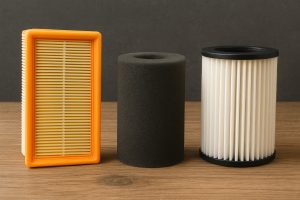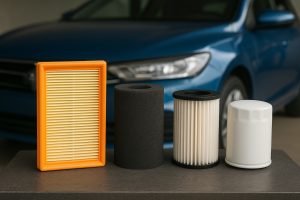Automotive filters may seem like simple components, but the material they are made from plays a major role in how effectively they protect your engine, cabin, or fuel system. Paper, foam, and cotton are the three most commonly used filter media in modern vehicles. Each one offers unique advantages, limitations, and ideal applications. Understanding their differences helps you choose the right filter for your driving style, climate, and vehicle type.
If you are planning to replace or upgrade your filters, you can easily buy filters online for any vehicle model.
Why Filter Material Matters

The material inside a filter determines:
-
Filtration efficiency
-
Airflow or fluid flow resistance
-
Durability and lifespan
-
Cost of ownership
-
Suitability for specific environments (dusty areas, cold climates, high-performance driving)
Choosing the right media ensures optimal engine performance, improved fuel economy, and longer service life for critical components.
Overview of Common Filter Materials
1. Paper (Cellulose) Filters
Paper filters are the most common type used in OEM applications. They are affordable, reliable, and designed for everyday driving.
Advantages:
-
High filtration efficiency for small particles
-
Low cost
-
Easy to replace
-
Stable performance in normal conditions
Disadvantages:
-
Moderate airflow
-
Not washable—must be replaced
-
Can clog faster in dusty environments
Best for: Daily drivers, normal road conditions, standard maintenance intervals.
2. Foam Filters
Foam filters are typically used in motorsport, off-road driving, and environments with high dust concentration. Their porous structure traps larger particles while maintaining strong airflow.
Advantages:
-
Excellent airflow for high-performance engines
-
Washable and reusable
-
Effective in extremely dusty conditions
Disadvantages:
-
Lower filtration efficiency for tiny particles unless oiled
-
Requires regular cleaning
-
Can degrade faster when exposed to chemicals
Best for: Off-road vehicles, ATVs, dirt bikes, racing engines.
3. Cotton (Oiled Cotton Gauze) Filters
Often branded as “performance filters,” cotton gauze filters are popular among enthusiasts who want long-term reusability and improved airflow.
Advantages:
-
High airflow
-
Long lifespan (washable and reusable)
-
Durable construction
-
Good filtration when oiled correctly
Disadvantages:
-
Higher initial cost
-
Requires proper cleaning and re-oiling
-
Over-oiling can affect sensors (e.g., MAF sensors in some cars)
Best for: High-performance street cars, tuned engines, long-term cost savings.
Comparison Table: Filter Material Performance
| Feature | Paper Filter | Foam Filter | Cotton Filter |
|---|---|---|---|
| Filtration efficiency | High | Medium–High (oiled) | Medium–High (oiled) |
| Airflow | Moderate | Very high | High |
| Reusability | No | Yes | Yes |
| Durability | Medium | Medium | High |
| Best use case | Daily driving | Off-road, dusty areas | Performance & longevity |
| Cost | Low | Medium | High |
Which Filter Material Should You Choose?
Choose Paper if:
-
You want low-cost, reliable filtration
-
You drive mainly on paved roads
-
You prefer simple, no-maintenance replacements
Choose Foam if:
-
You drive off-road, in forests, deserts, or construction zones
-
You need excellent airflow plus high dust management
-
You don’t mind washing the filter regularly
Choose Cotton if:
-
You want improved airflow for performance or tuned engines
-
You prefer reusable components
-
You are willing to maintain the filter properly
Additional Considerations
Climate
-
Dry, dusty regions: Foam or cotton (oiled properly)
-
Moist or cold climates: Paper performs well without moisture saturation issues
Driving Style
-
Calm, economical driving: Paper is ideal
-
Sporty or high-RPM driving: Cotton provides more airflow
-
Off-road or rally use: Foam handles dust best
Long-Term Cost
While cotton and foam filters cost more upfront, their reusability often makes them cheaper over a vehicle’s lifetime.
Table: Maintenance Requirements
| Filter Type | Cleaning Needed | Replacement Interval | Notes |
|---|---|---|---|
| Paper | None | Every 10,000–20,000 km | Ideal for quick maintenance |
| Foam | Every 5,000–10,000 km | Reusable | Needs special cleaning solutions |
| Cotton | Every 20,000–50,000 km | Reusable | Must be re-oiled correctly |
Conclusion

Paper, foam, and cotton filters each offer unique strengths. Paper filters are perfect for everyday drivers who want inexpensive, hassle-free maintenance. Foam filters excel in dusty or off-road conditions where durability and airflow are crucial. Cotton filters strike a balance between long-term value and high performance, making them ideal for tuned or high-output engines.
Ultimately, the right choice depends on your driving habits, environment, and performance expectations. When you’re ready to replace or upgrade your filter, you can conveniently buy filters online and choose the material that best fits your needs.